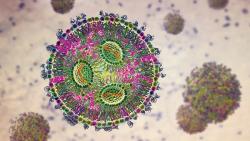
OR WAIT null SECS
- About Us
- Advertise
- Contact Us
- Editorial Info
- Editorial Contacts
- Editorial Advisory Board
- Do Not Sell My Personal Information
- Privacy Policy
- Terms and Conditions
© 2024 MJH Life Sciences™ and Pharmaceutical Technology. All rights reserved.
Viewpoint: The Driver of Drug Delivery
Advances in medicine and consumer electronics can enhance drug delivery and patient care.
When I started my career, I worked in underground coal mines doing research aimed at preventing workers from inhaling small particles into their lungs. In 1996, 3M hired me to do the same thing but in reverse-researching how to get people to inhale small particles into their lungs. Since then, I’ve been amazed at the progress in the drug-delivery space. Today, it is all being driven by new and ever-changing technologies.
Before we talk about today and tomorrow, however, I think it’s important to take a step back in time to understand where we’ve been. For instance, the delivery of therapeutic vapors and aerosols via inhalation has been used for thousands of years in various cultures. The first known reference to therapeutic aerosol delivery is an ancient Egyptian papyrus scroll dating back to approximately 1554 BC, which purportedly was discovered between the legs of a mummy. This papyrus describes how patients were struggling to breathe inhaled the vapor formed when black henbane plants were placed on hot bricks.
Over the centuries, discoveries from many cultures advanced the delivery of therapeutic aerosols. For thousands of years, they were prepared by the patient or a physician with direct oversight of the patient using custom-made delivery systems. With the start of the Industrial Revolution, advancements in manufacturing resulted in the bulk production of therapeutic aerosol delivery systems by people completely disconnected from contact with the patient.
In the 1950s, 3M invented the first metered dose inhaler (MDI). Additional breakthroughs will be driven in part by two factors: technological innovations and technology’s impact on society.
Smarter drug delivery
Today, when you walk down the street and look around, it seems like everyone is glued to their smartphones. As a society, we’re growing more and more accustomed to getting the information we want faster than ever before and in a way that is tailored to our individual preferences. Everything is personalized and on demand. We are starting to see this becoming true with regard to how drugs are delivered to patients.
Smartphones, for example, are starting to be used with smart-connected inhalers, which have been designed to give patients a personalized experience. One size no longer fits all. In fact, it never really has. Research shows that many asthma and chronic obstructive pulmonary disease (COPD) patients don’t properly use their inhalers, if they even use them at all. The error rate is unacceptably high.
Connected inhalers are being developed that utilize sensing technologies that can detect whether the patient has correctly used their inhaler. For example, has the patient inhaled long enough to get the full dose of the drug? The patient will also be able to connect to a smartphone or tablet. A mobile app can remind a patient to take the drug, instruct him/her on how to use it, and finally, record data to help guide and improve future treatment decisions.
Data that can be drawn from devices will allow scientists to sift through massive amounts of information from diverse populations. This information will undoubtedly help us understand how to improve current systems, driving further technological advancements and innovations.
With these developments, however, come new challenges. As our ability to collect information has grown exponentially, one of the biggest hurdles we face is how to manage and use the data that is collected. Often patients want as much data as they can get, but health care providers cannot keep up with all of the data that can be generated. It is important to identify which data are critical. This isn’t always clear. It is also challenging for regulatory agencies to keep up with the ever-changing and growing information that new technologies enable.
Challenges aside, I’m excited for what’s ahead. Among other advancements, technology could make it possible for inhalation therapy to go from fighting asthma and COPD to fighting lung cancer. We know we have the ability to reach the lungs and put the treatment in the optimal place. As we see improved treatments, such as genetic matching of therapies to patients, the opportunities to help patients that once had little hope for survival will only continue to grow.
Of course, technology is driving drug delivery in many areas other than inhalation. For instance, advancements in microneedle technology are helping to meet the needs of patients with needle phobia, and at the same time, get the drug to an area of the body where it can have maximum impact on a patient. Cancer patients are already greatly benefiting from cancer therapies that target specific patient subpopulations based on their genetic composition or even genetic information from the cancer cells themselves.
Past, present, and future
Ideally, new technologies will allow us to better identify what medical intervention is needed, improve the effectiveness of medical conditions, reduce overall health care costs, and make the user experience better. I think they will also make for a more informed populace. Technology is training us to want instant information, so it shouldn’t surprise us if that carries over to health care information.
In a way, today’s technological advancements are also helping us to merge the past with the present and future. We can now take the once-personalized treatment approach from centuries ago and marry it with the swiftness of mass production. It gives us the best of both worlds, and most importantly, empowers patients to take control of their own health in ways that have never before been possible.
About the Author
Steve Stein is lead research specialist, 3M Drug Delivery Systems



